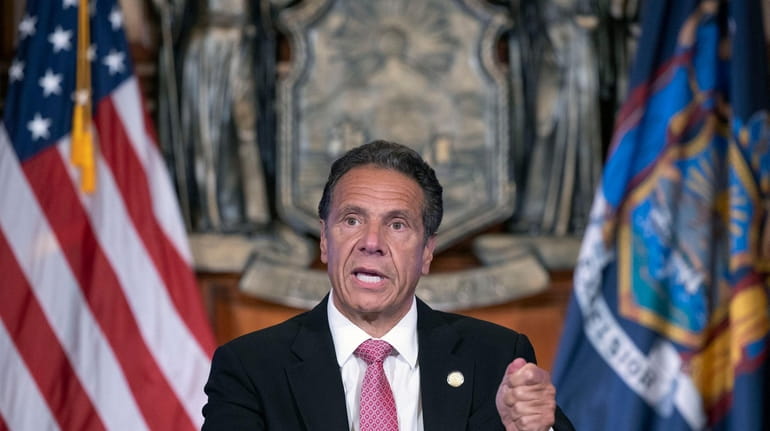Gathering storm clouds

Gov. Andrew M. Cuomo at a news briefing at the State Capitol in Albany on July 24. Credit: Office of Governor Andrew M. Cuomo / Mike Groll
Daily Point
All bets are off
In June, as the coronavirus infection and death numbers in New York were waning, the six upstate casinos operated by the Oneida and Seneca nations opened up for business with limited capacity and new precautions. Mohegan Sun and Foxwoods, in Connecticut, were also allowed to open in June, as were Pennsylvania’s casinos. And Atlantic City’s casinos began opening in the first week of July.
In this region, only New York’s non-Indian casinos and slot parlors remain closed, a fact that’s costing the state and Nassau and Suffolk counties a fortune in lost revenue. It’s also keeping people out of work and causing local gamblers to travel for their games. The heads of the Nassau and Suffolk OTBs don’t quite understand why they’re still shut or know when they’ll hear the slots ring again.
—Lane Filler @lanefiller
Talking Point
Calling out for help to end housing segregation on LI
A group of Long Island housing advocates is asking Attorney General Letitia James to take a greater role in one of the region’s most intractable issues: housing segregation, a topic much on the mind of President Donald Trump these days. The letter focuses on the suburbs’ need for more multi-family housing, and notes that continued opposition to zoning changes can prevent such apartments and other housing types from being built.
Housing segregation, the letter said, is partially caused by municipalities that don’t allow all housing types to be built in their communities, even though that’s “part of their responsibility and legal obligations to the larger region and state.”
“Such segregation is not just perpetuated by the planning and zoning actions of our towns and villages but also by the opposition to such multi-family developments by our school districts, even to the point that litigation against the project is paid for by the taxpayers of the school district,” the letter said.
The group suggested that James write to every town and village on Long Island, asking them to provide a list of properties zoned for multi-family development as of right – meaning without a zoning change. Such lists – or lack thereof – will portray just how the region’s housing segregation is perpetuated, and could provide the basis for further action by the attorney general, they wrote. Right now, the letter said, Long Island’s multi-family housing is more often than not located in minority neighborhoods across the region. Giving people more housing options in every community, including affordable multi-family housing, could stop perpetuating such segregation, as it would spread a variety of housing types and prices to every part of the Island.
The letter’s co-signers included Mitch Pally of the Long Island Builders Institute, David Okorn with Long Island Community Foundation, Jim Morgo, formerly with the Long Island Housing Partnership, Elaine Gross from Erase Racism, Tessa Hultz of the Long Island Board of Realtors, Gwen O’Shea with the Community Development Corp. of Long Island, Ian Wilder of Long Island Housing Services, and Thomas Wright with the Regional Plan Association.
Pally told The Point that he has made similar arguments to state attorneys general for years. But the effort to get James involved began last fall, after Newsday’s Long Island Divided series was published. He and other advocates had two meetings with James and her staff, but hadn’t heard anything further in more recent months. The advocates hope the new letter will push James to act.
“The Attorney General’s office has to understand that the Long Island Divided stories and the issue of segregation on Long Island is more than just the fact that someone can’t get an apartment where he wants to live. The fact that the apartment didn’t get built in the first pace in the right place is the start of segregation on Long Island,” Pally said. “A lot of this is built out of why we are the most segregated area in the country.”
Pally said he’d like to see towns and villages rezone land for multi-family housing on a broader scale, without having to wait for a developer to propose a specific plan, only to see it fought against for years.
Last fall, James said she would investigate the unequal treatment of minority home buyers by real estate agents, as discussed in Newsday’s series. That investigation remains ongoing. A spokeswoman for the Attorney General’s office declined comment on the advocates’ most recent letter.
Suburban housing issues have taken center stage nationally, as Trump has spoken and tweeted with racially-divisive language about efforts to roll back Obama-era programs that expanded Fair Housing Act provisions. Trump wrote that people living “their Suburban Lifestyle Dream” would “no longer be bothered or financially hurt by having low income housing built in your neighborhood,” implying that ending the Obama program would allow property values to rise and crime to fall.
Pally rejected the implications, noting that suburbs like Long Island need more multi-family housing, and that such efforts don’t adversely affect property values.
“You show me one place on Long Island where that has happened,” Pally said. “I have never seen it.”
—Randi F. Marshall @RandiMarshall
Pencil Point
The power of suggestion

Christopher Weyant
For more cartoons, visit www.newsday.com/cartoons
Final Point
CD1 in the eye of the hurricane?
There are plenty of external and predictable factors that will have an effect on Long Island’s congressional races, from the economy to the coronavirus to the popularity and actions of President Donald Trump.
Here’s another potential one: coastal storms.
Scientists are predicting a busy Atlantic hurricane season this year, and if drastic weather makes its way up the East Coast not long before Election Day, that could have a particularly interesting impact on CD1.
The district is long, with plenty of seafront. And in that contest, Democrat Nancy Goroff is the former chair of the Stony Brook University chemistry department who has run strenuously on her scientific background and has steadfastly made climate change a crucial issue.
Polling data suggests that “the dots are starting to get connected” regarding climate change, said Bruce Gyory, a New York Democratic political consultant, indicating that it’s a real issue affecting real lives.
If so, that could make incumbent Lee Zeldin vulnerable to criticism. The Shirley Republican has in the past walked a fine line on environmental issues, noting during a 2014 Newsday endorsement interview that “everyone here on Long Island is pro-environment” and saying he supports alternative energy sources like solar.
He is a member, along with other Long Island representatives, of the bipartisan House Climate Solutions Caucus, and when asked about his climate record his spokeswoman pointed to local environmental efforts as well as more national measures, such as voting against a GOP effort to make the Secretary of Defense skip a report on the impact of climate change. It’s part of an image he’s fostered of being less interested in climate rhetoric than “good sensible policies.”
But he has also expressed some of the climate skepticism predominating in the national Republican Party, which as a whole has stood in the way of aggressive action on climate change. In that 2014 interview ahead of Zeldin’s first winning congressional campaign, he declined to support a carbon tax and said that “there's so many disagreements and debates about what exactly is true and what's not true with regards to climate change.” He added, “I’m not sold yet on the whole argument that we have as serious a problem with climate change as other people are."
The effect of a weather disaster on the scale of superstorm Sandy or a named hurricane coming on shore would be hard to predict. Sandy allowed incumbents like New Jersey Gov. Chris Christie to win plaudits for bipartisan response. On the other hand, voters may get angry if the emergency response isn’t well-executed with FEMA already busy with that other disaster, the coronavirus pandemic.
—Mark Chiusano @mjchiusano
